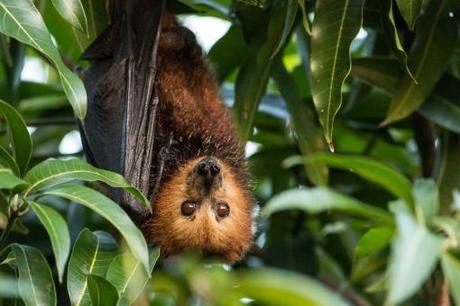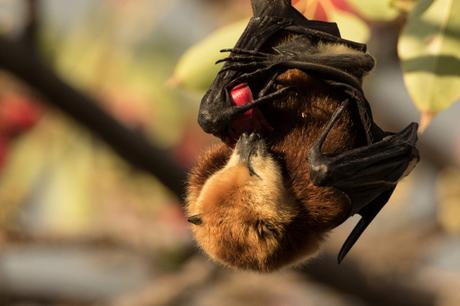The island of Mauritius is known, particularly in conservation circles, for the ill-fated extinction of the dodo, but also for its many conservation success stories. These include the recovery of emblematic birds such as the Mauritius kestrel (Falco punctatus) and the pink pigeon (Nesoenas mayeri) that narrowly avoided extinction several decades ago.
 Mauritius (greater Mascarene) flying fox Pteropus niger
Mauritius (greater Mascarene) flying fox Pteropus nigerBehind this veil of achievements, however, local political realities are increasingly making the protection and management of Mauritian biodiversity more complex and challenging as new conservation issues emerge.
Emergence of human-wildlife conflict
In the midst of the third government-led mass cull of the Endangered Mauritian flying fox (Pteropus niger) in 2018, a paper published in the Journal for Nature Conservation shed light on the events that led to the government’s choice to do the first two mass culls of the Mauritian flying fox in 2015 and 2016. Documentation of human-wildlife conflict in Mauritius is relatively new, as noted by the authors, but provides a unique case study.
Given that the mass-culling opted for did not increase fruit growers’ profits (in fact, fruit production dropped substantially after the mass-culls) and that the flying fox, a keystone species for the native biodiversity, became more threatened with extinction following the mass culls, it appears that Mauritius provides a rare opportunity to study what precisely should be avoided when trying to resolve such a HWC [Human-wildlife conflict],
Florens & Bader (2019)
Indeed, to mitigate rising conflicts between fruit farmers and the Mauritian flying fox, the Mauritian government opted in 2006 to cull this threatened species (only six individuals were culled at the time). Despite disputes over the population size of the Mauritian flying fox and the extent of damage it caused to commercial fruit growers, as well as scientific arguments against the cull, culling continues to be the preferred approach.
The law that kills threatened wildlife
This focus on culling as a solution contributed to a legal amendment in October 2015 that now facilitates the population control of any species of wildlife, irrespective of its origin and its conservation status. The Native Terrestrial Biodiversity and National Parks Bill was passed on 20 October 2015, just two weeks after the government announced its plan to cull 18,000 threatened native bats.
The Act came into force on 1 November 2015, six days before the start of the first mass cull of the Mauritian flying fox done during the breeding season. This initial cull lasted almost a month, longer than originally announced, and according to official figures resulted in the death of 30,938 individual bats, 42% more than what was originally planned. In 2016, 7380 more bats were killed, and figures for the 2018 mass cull have still not been made public.

This new law includes the establishment of a Special Technical Committee for the purpose of controlling wildlife in Mauritius and a Section 37 stating that:
A written authorisation to control such species of wildlife as may be prescribed may be exceptionally granted by the Minister to any person, even where such a species exists in small numbers but constitutes a threat, at such a strategic location as he may determine in the national interest.
Section 37 of the 2015 Native Terrestrial Biodiversity and National Parks Act of the Republic of Mauritius
This is a major step backward for the country in terms of conservation governance.
The Republic of Mauritius was one of the first countries to sign and ratify the Convention on Biological Diversity in September 1992. This global landmark agreement took shape locally with the adoption of multiple laws including the Wildlife and National Parks Act 1993 that provided legal protection to native fauna and flora.
Its successor, which ironically meant “… to make further and better provision for the protection, conservation and management of native terrestrial biodiversity in Mauritius”, did not only undo conservation milestones from more than two decades ago, but also created what is possibly an unprecedented legal conundrum with regards to the protection of threatened species in Mauritius.
Was it worth it?
As highlighted in the Journal for Nature Conservation paper and another one in Science, the main outcomes of the mass culls were an increase in endangerment of Mauritian biodiversity, with the keystone Mauritian flying fox being listed since July 2018 as Endangered on the IUCN Red List. Meanwhile, any benefits to fruit farmers have yet to manifest.
Following the first two mass culls, fruit production dropped by 70% in 2017 due to adverse climatic conditions, suggesting a weak or non-existent link between culling of the Mauritian flying fox and increased fruit production. Local scientists had already warned prior to the first mass cull that this approach was unlikely to benefit fruit farmers, because fruit yield is not solely influenced by presence of flying foxes.
There are also other factors involved, such as birds and rats that contribute to fruit loss. And unexpected climatic events clearly present a bigger threat given the uncertainties on their timing, the nature of their impacts (e.g., trees not flowering) and the potential extent of their impacts.
If culling of the Mauritian flying fox is meant to help fruit farmers, maybe the resources required could be put to better use by investing directly in farm-related expenses — such as being diverted to priorities that support the implementation of objectives in the Mauritian 2016-2020 Strategic Plan for the Food Crop, Livestock and Forestry Sectors:
To build capacity for enabling farmers to face climate change and move on to ‘climate-smart agriculture.
Mauritius Strategic Plan (2016-02020) for the Food Crops, Livestock and Forestry Sectors
The need for accountability
We are yet to see a proper evaluation of the Mauritian Government’s decision to implement three mass culls of a threatened species. We are yet to see evidence that the culls have directly contributed to increased fruit production. What we have been given so far are words comparing increased fruit production in protected trees (by netting) to non-protected trees. This was in fact already known well before the first cull, and it only indicates that culling does not work.
Following the events of 2017, we also need new figures on these ‘benefits’ of culling that effectively isolate the influence of favourable climatic conditions, as was the case in 2018.
In addition to being a conservationist/scientist, I am above all Mauritian, and I want my government to be accountable for their decisions. Were the mass culls needed or even wanted by fruit farmers? Were they only meant to please fruit farmers? How can we justify the destruction of a key component of Mauritian natural heritage if it is a misinformed decision and goes against available scientific information? Where are the evaluations of these decisions? Do all members of the Special Technical Committee have sufficient expertise to bring in the necessary ecological, economic, and socio-political knowledge to advise on the control of wildlife effectively, and are they the best representatives in each of these categories?
And one question for conservationists worldwide: As the call for a new deal for nature is getting louder, can we not be bolder moving forward to ensure that these global deals translate into effective governance at the national level?

